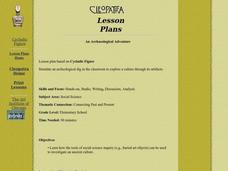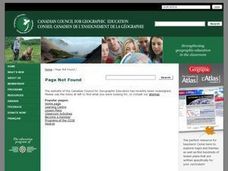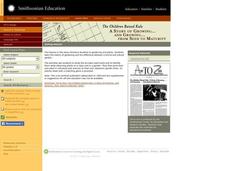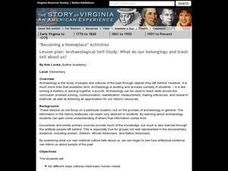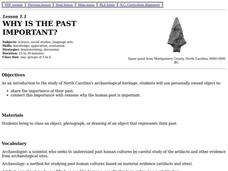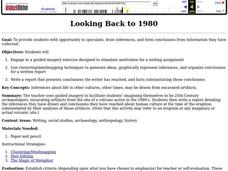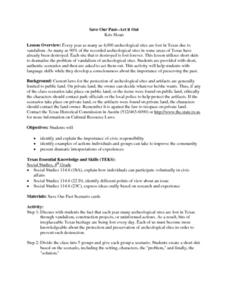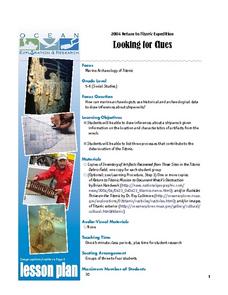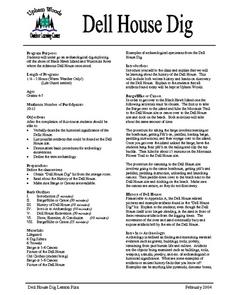Curated OER
Inventions over Time
Sixth graders examine inventions, such as spear points and bows and arrows, and discuss their importance in human cultural development. They compare these early inventions with modern ones and determine the impact of science and...
Curated OER
An Archaeological Adventure
Pupils simulate an archeological dig in the classroom to explore a culture through its artifacts.
Curated OER
Why is the Past Important?
Students explore, examine and study why it's important to study the past and connect this importance with reasons why we should learn from the past and how cultures have changed over the years. They bring an object, photograph or a...
Curated OER
Ancient Recipes
Young scholars explore how foods and their preparation differ over time and from culture to culture. An ancient recipe for the preparation of goat, found by archaeologists, is examined and discussed by the students.
Curated OER
Baga Drum
Students examine a Baga Drum in order to explore the history of the Baga people of West Africa. In this art history lesson, students recognize figures used in Baga Drum design that represent aspects of Baga culture. They also design and...
Curated OER
Vikings in Vinland
Students examine the role of archaeology in gaining information about past civilizations. After reading an article, they discover evidence of the Viking settlement of North America. They summarize the information in the article by...
Curated OER
Spear Point Production
Young scholars explore that prehistoric people had to have a good knowledge of the physical world around them in order to choose the best material for spear production. They also explore that prehistoric people were intelligent beings...
Curated OER
Clues to the Past
Students analyze how arhaeologists study the past. They define basic archaeological terms, make general inferences from observations, and explain the importance of context.
Curated OER
Before It Was Wisconsin-Rock Art
Students examine how archaeologists make use of all forms of artifacts including rock art to try to piece together past cultures. They make their own rock art so they have a feel for how such pieces were made out of natural materials.
Curated OER
"how To Think Like an Archaeologist" Suggested Pre-visit Activity for Historic Jamestowne
Students study grocery receipts to simulate the archaeological activity of classifying items. They discuss the receipts as if they were find lists.
Curated OER
Advances in Civilization: A Car or a Horse?
Fourth graders investigate the ways in which horses made transportation, hunting and agriculture much easier for the native peoples. They then compare advantages of a horse "back then" to the ease transportation (mainly cars) make on our...
Curated OER
Archaeological Self-Study: What Do Our Belongings and Trash Tell About Us?
Students examine how their belongings and their trash represents who they are. In this archaeology skills lesson, students watch a video titled "Discovering the Past" and then give archaeological techniques a try. Students examine and...
Curated OER
Why is the Past Important?
Fourth graders discuss the importance of North Carolina's archaeological heritage. They share with the class an object, photograph, or drawing of an object that represents their own or their family's past.
Curated OER
Stratigraphy and Cross-Dating
Students interpret archaeological strata using the law of superposition. They apply cross-dating to determine the age of other artifacts.
Curated OER
Looking Back to 1980
Pupils use clustering/mind mapping techniques to generate ideas, graphically represent inferences, organize their conclusions and write a report that presents conclusions the writer has reached, and facts substantiating those conclusions.
Curated OER
Gridding a Site
Learners make observations of effigy mounds and record them in a notebook. In groups, they must determine the scale of measurement and create their own grid to scale part of the Effigy Mounds National Monument. They also practice using...
Curated OER
Point of View
Students participate in an inkblot test to discuss how what they see is different than their classmates. After viewing various artifacts, they write down what they believe the object is and then they are placed into a group to discuss...
Curated OER
Vocabulary Charts
Seventh graders are introduced to the vocabulary associated with archeology. Using a dictionary, they practice finding the meaning of various words and create sentences. They also identify an appropriate use of the word and draw an...
Curated OER
Meet You at the Midden: Map Game
Students examine sketch map of Burrets' Trail at the Nightengale Archaeological Center, interpret map symbols to play game, and identify reasons people modify environment to meet their basic needs.
Curated OER
Save Our Past -- Act It Out
Fourth graders identify and examine the importance of civic responsibility and the result of losing many archeological sites in Texas. In groups, they are given scenerio cards and act out each scene for the class. They also write a...
Curated OER
Reconstructing Artifacts
Students investigate artifacts and reconstruct them. In this artifact lesson, students research archaeologists and Native American groups. Students plan a design for a clay pot which represent the Native American artifact.
Curated OER
Titanic: Looking for Clues
Young scholars make inferences about a shipwreck based on the location of artifacts. They role play as marine archaeologists and list three processes that contribute to the deterioration of the Titanic.
Curated OER
Artifact Puzzles
Pupils role-play the position of archaeologists to determine the different types of artifacts. They cut out a drawing of their object and connect them with their classmates objects. They write an essay about their object and where it was...
Curated OER
Dell House Dig
Pupils experience an archaeological dig exploring off the shore of Black Hawk Island and Wisconsin River. They study in the same place where the infamous Dell House once stood. Dell House and its historical significance is reviewed...



